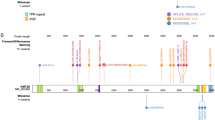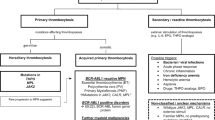Abstract
We retrospectively evaluated the relationship between serum transferrin receptor-1 (sTfR1) and some fundamental events in the life and the management (the age at diagnosis, the age at the first red blood cells transfusion, the age at splenectomy, and the overall need of chelation therapy) of 111 patients with non-transfusion-dependent thalassemia (NTDT) subdivided in four genetic entities: patients with homozygous or compound heterozygous state for β-thalassemia, patients with triplicated α genotype associated with β heterozygosity, patients with deletional HbH, and patients with the combination of a β defect plus a β chain variant. We found that the group with homozygous or compound heterozygous state for β-thalassemia had the highest sTfR1 levels and that the presence of increased sTfR1 levels (>5 times normal) was associated with a complex and severe history of disease requiring splenectomy, occasional red blood cells transfusions, and early start and continuous iron chelation therapy.
The complexity in the management of NTDT patients is an emerging issue due to the wide heterogeneity of clinical behavior. Our data indicate that the measurement of sTfR1 levels, a common laboratory test, could contribute to correctly stratify disease history and the iron chelation strategy in NTDT patients.



Similar content being viewed by others
References
Cao A, Galanello R (2010) Beta-thalassemia. Genet Med 12(2):61–76
Galanello R (2012) Recent advances in the molecular understanding of non-transfusion-dependent thalassemia. Blood Rev 26(Suppl 1):S7–S11
Ricchi P, Filosa A, Maggio A, Fucharoen S (2015) Non-transfusion-dependent thalassemia: a complex mix of genetic entities yet to be fully discovered. Biomed Res Int 15:161434
Musallam KM, Rivella S, Vichinsky E, Rachmilewitz EA (2013) Non-transfusion-dependent thalassemias. Haematologica 98(6):833–844
Taher A, Isma’eel H, Cappellini MD (2006) Thalassemia intermedia: revisited. Blood Cells Mol Dis 37(1):12–20
Taher A, Musallam KM, El Rassi F et al (2009) Levels of non-transferrin-bound iron as an index of iron overload in patients with thalassemia intermedia. Br J Haematol 146(5):569–572
Musallam KM, Cappellini MD, Wood JC et al (2011) Elevated liver iron concentration is a marker of increased morbidity in patients with beta thalassemia intermedia. Haematologica 96(11):1605–1612
Musallam KM, Taher AT, Duca L, Cesaretti C, Halawi R, Cappellini MD (2011) Levels of growth differentiation factor-15 are high and correlate with clinical severity in transfusion-independent patients with beta thalassemia intermedia. Blood Cells Mol Dis 47(4):232–234
Musallam KM, Sankaran VG, Cappellini MD, Duca L, Nathan DG, Taher AT (2012) Fetal hemoglobin levels and morbidity in untransfused patients with beta-thalassemia intermedia. Blood 119(2):364–367
Fierbinteanu-Braticevici C, Dina I, Petrisor A, Tribus L, Negreanu L, Carstoiu C (2010) Noninvasive investigations for non alcoholic fatty liver disease and liver fibrosis. World J Gastroenterol 16(38):4784–4791
Porter JB, Cappellini MD, Kattamis A et al (2017) Iron overload across the spectrum of non-transfusion-dependent thalassemias: role of erythropoiesis, splenectomy and transfusions. Br J Haematol 176(2):288–299
Ricchi P, Ammirabile M, Costantini S et al (2012) A useful relationship between the presence of extramedullary erythropoeisis and the level of the soluble form of the transferrin receptor in a large cohort of adult patients with thalassemia intermedia: a prospective study. Ann Hematol 91(6):905–909
Ricchi P, Ammirabile M, Costantini S et al (2016) Soluble form of transferrin receptor as a biomarker of overall morbidity in patients with non-transfusion-dependent thalassemia: a cross-sectional study. Blood Transfus 14(6):538–540
Meloni A, Ramazzotti A, Positano V et al (2009) Evaluation of a web-based network for reproducible T2* MRI assessment of iron overload in thalassemia. Int J Med Inform 78(8):503–512
Ramazzotti A, Pepe A, Positano V et al (2009) Multicenter validation of the magnetic resonance t2* technique for segmental and global quantification of myocardial iron. J Magn Reson Imaging 30(1):62–68
Pepe A, Positano V, Santarelli F et al (2006) Multislice multiecho T2* cardiovascular magnetic resonance for detection of the heterogeneous distribution of myocardial iron overload. J Magn Reson Imaging 23(5):662–668
Pepe A, Lombardi M, Positano V et al (2006) Evaluation of the efficacy of oral deferiprone in beta-thalassemia major by multislice multiecho T2*. Eur J Haematol 76(3):183–192
Positano V, Pepe A, Santarelli MF et al (2007) Standardized T2* map of normal human heart in vivo to correct T2* segmental artefacts. NMR Biomed 20(6):578–590
Meloni A, Positano V, Pepe A et al (2010) Preferential patterns of myocardial iron overload by multislice multiecho T*2 CMR in thalassemia major patients. Magn Reson Med 64(1):211–219
Cerqueira MD, Weissman NJ, Dilsizian V et al (2002) Standardized myocardial segmentation and nomenclature for tomographic imaging of the heart: a statement for healthcare professionals from the Cardiac Imaging Committee of the Council on Clinical Cardiology of the American Heart Association. Circulation 105(4):539–542
Anderson LJ, Holden S, Davis B et al (2001) Cardiovascular T2-star (T2*) magnetic resonance for the early diagnosis of myocardial iron overload. Eur Heart J 22(23):2171–2179
Meloni A, Luciani A, Positano V et al (2011) Single region of interest versus multislice T2* MRI approach for the quantification of hepatic iron overload. J Magn Reson Imaging 33(2):348–355
Meloni A, Rienhoff HY Jr, Jones A, Pepe A, Lombardi M, Wood JC (2013) The use of appropriate calibration curves corrects for systematic differences in liver R2* values measured using different software packages. Br J Haematol 161(6):888–891
Wood JC, Enriquez C, Ghugre N et al (2005) MRI R2 and R2* mapping accurately estimates hepatic iron concentration in transfusion-dependent thalassemia and sickle cell disease patients. Blood 106(4):1460–1465
Taher A, Vichinsky E, Musallam K, Cappellini MD, Viprakasit V (2013) Guidelines for the clinical management of non-transfusion dependent thalassemia (NTDT), Edited by D. Weatherall
Pippard MJ, Callender ST, Warner GT, Weatherall DJ (1979) Iron absorption and loading in beta-thalassemia intermedia. Lancet 2(8147):819–821
Pootrakul P, Kitcharoen K, Yansukon P et al (1988) The effect of erythroid hyperplasia on iron balance. Blood 71(4):1124–1129
Taher AT, Porter J, Viprakasit V et al (2012) Deferasirox reduces iron overload significantly in nontransfusion-dependent thalassemia: 1-year results from a prospective, randomized, double-blind, placebo-controlled study. Blood 120(5):970–977
Cazzola M, Beguin Y, Bergamaschi G et al (1999) Soluble transferrin receptor as a potential determinant of iron loading in congenital anaemias due to ineffective erythropoiesis. Br J Haematol 106(3):752–755
Author information
Authors and Affiliations
Corresponding author
Ethics declarations
Conflict of interest
The authors declare that they have no conflict of interest.
Rights and permissions
About this article
Cite this article
Ricchi, P., Meloni, A., Costantini, S. et al. Soluble form of transferrin receptor-1 level is associated with the age at first diagnosis and the risk of therapeutic intervention and iron overloading in patients with non-transfusion-dependent thalassemia. Ann Hematol 96, 1541–1546 (2017). https://doi.org/10.1007/s00277-017-3057-z
Received:
Accepted:
Published:
Issue Date:
DOI: https://doi.org/10.1007/s00277-017-3057-z




